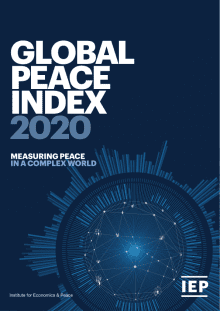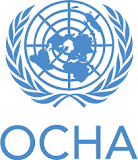Global Peace Index 2020
TMS PEACE JOURNALISM, 6 Jul 2020
OCHA-United Nations Office for the Coordination of Humanitarian Affairs - TRANSCEND Media Service
Download PDF file: Global Peace Index 2020
Executive Summary
11 Jun 2020 – This is the 14th edition of the Global Peace Index (GPI), which ranks 163 independent states and territories according to their level of peacefulness. Produced by the Institute for Economics and Peace (IEP), the GPI is the world’s leading measure of global peacefulness. This report presents the most comprehensive datadriven analysis to-date on trends in peace, its economic value, and how to develop peaceful societies.
The GPI covers 99.7 per cent of the world’s population, using 23 qualitative and quantitative indicators from highly respected sources, and measures the state of peace across three domains: the level of Societal Safety and Security; the extent of Ongoing Domestic and International Conflict; and the degree of Militarisation.
In addition to presenting the findings from the 2020 GPI, this year’s report includes an analysis of the effect of the COVID-19 pandemic on peace, including Positive Peace: the attitudes, institutions and structures that create and sustain peaceful societies. It examines how the impact of the pandemic, and in particular its economic consequences will increase the risk of severe deteriorations in Positive Peace over the next few years, and also examines which countries are best placed to recover from the shock.
The results this year show that the level of global peacefulness deteriorated, with the average country score falling by 0.34 per cent. This is the ninth deterioration in peacefulness in the last twelve years, with 81 countries improving, and 80 recording deteriorations over the past year. The 2020 GPI reveals a world in which the conflicts and crises that emerged in the past decade have begun to abate, only to be replaced with a new wave of tension and uncertainty as a result of the COVID-19 pandemic.
Iceland remains the most peaceful country in the world, a position it has held since 2008. It is joined at the top of the index by New Zealand, Austria, Portugal, and Denmark.
Afghanistan is the least peaceful country in the world for the second year in a row, followed by Syria, Iraq, South Sudan and Yemen. All, except Yemen, have been ranked amongst the five least peaceful since at least 2015.
Only two of the nine regions in the world became more peaceful over the past year. The greatest improvement occurred in the Russia and Eurasia region, followed by North America. North America was the only region to record improvements across all three domains, while Russia and Eurasia recorded improvements in Ongoing Conflict and Safety and Security, but a deterioration on the Militarisation domain.
South America and Central America and the Caribbean recorded the largest and second largest deterioration on the 2020 GPI. While South America’s average deterioration in peacefulness was driven by deteriorations on Militarisation and Safety and Security, the fall in peacefulness in Central America and the Caribbean was driven by changes in Ongoing Conflict.
Peacefulness has declined 2.5 percent since 2008 with 81 GPI countries recording a deterioration, and 79 improving. Fifteen of the 23 GPI indicators are less peaceful on average in 2020 when compared to 2008.
Two of the three GPI domains deteriorated over the past decade, with Ongoing Conflict deteriorating by 6.8 per cent and Safety and Security deteriorating by 3.3 per cent. Terrorism and internal conflict have been the biggest contributors to the global deterioration in peacefulness. Ninety-seven countries recorded increased terrorist activity, while only 43 had lower levels of terrorism. However, after peaking in 2014 during the height of the Syrian civil war, total deaths from terrorism have fallen every year for the last five years.
By contrast, the Militarisation domain has recorded a 4.4 per cent improvement since 2008. The number of armed services personnel per 100,000 people has fallen in 113 countries, and military expenditure as a percentage of GDP fell in 100.
This year’s report also looks at the trends in civil unrest over the past decade. It finds that there has been a sharp increase in civil unrest events since 2011, with over 96 countries experiencing at least one violent demonstration in 2019. From 2011 to 2019, the number of riots rose by 282 per cent and general strikes rose by 821 per cent.
Europe had the largest number of protests, riots and strikes over the period, totalling nearly 1,600 events from 2011 to 2018. Sixty-five per cent of the civil unrest events in Europe were nonviolent. Civil unrest in sub-Saharan Africa rose by more than 800 per cent over the period, from 32 riots and protests in 2011 to 292 in 2018.
Download PDF file: Global Peace Index 2020
Tags: Culture of Peace, Peace, Peace Research, Peacebuilding, Peaceful Transformation
DISCLAIMER: The statements, views and opinions expressed in pieces republished here are solely those of the authors and do not necessarily represent those of TMS. In accordance with title 17 U.S.C. section 107, this material is distributed without profit to those who have expressed a prior interest in receiving the included information for research and educational purposes. TMS has no affiliation whatsoever with the originator of this article nor is TMS endorsed or sponsored by the originator. “GO TO ORIGINAL” links are provided as a convenience to our readers and allow for verification of authenticity. However, as originating pages are often updated by their originating host sites, the versions posted may not match the versions our readers view when clicking the “GO TO ORIGINAL” links. This site contains copyrighted material the use of which has not always been specifically authorized by the copyright owner. We are making such material available in our efforts to advance understanding of environmental, political, human rights, economic, democracy, scientific, and social justice issues, etc. We believe this constitutes a ‘fair use’ of any such copyrighted material as provided for in section 107 of the US Copyright Law. In accordance with Title 17 U.S.C. Section 107, the material on this site is distributed without profit to those who have expressed a prior interest in receiving the included information for research and educational purposes. For more information go to: http://www.law.cornell.edu/uscode/17/107.shtml. If you wish to use copyrighted material from this site for purposes of your own that go beyond ‘fair use’, you must obtain permission from the copyright owner.
One Response to “Global Peace Index 2020”
Read more
Click here to go to the current weekly digest or pick another article:
TMS PEACE JOURNALISM:

I’m afraid I disagree that Iceland is a ‘peaceful’ country. Collaborating with wars, accepting without any barriers wars organisad and carried out by their allies. From 1951 to 2006 , the Keflavik Air Base was occupied by the American Armed Forces, from were many wars started, including the bombing of Serbia and Kosovo and Iraq. The US Forces left in 2006 but retirnd in 2016 and their presence in Iceland has grown steadily.
The US collection of air-fighters in Iceland includes the B2 stealth bomber capable of carrying nuclear weapons.
Last year, when visiting Iceland, Mike Pompeo said that “Iceland is a steadfast NATO ally” and “We thank Iceland for its assistance with the Resolute Support Mission in Afghanistan and the Coalition to Defeat ISIS.”
A press release issued by the ‘United States Air Forces in Europe last year stated: “The use of strategic bombers in Iceland helps exercise Naval Air Station Keflavik as a forward location for the B-2, ensuring that it is engaged, postured and ready with credible force to assure, deter and defend the U.S. and its allies in an increasingly complex security environment.”
They are conspirators in the deadly wars negotiated between Washington and her fighting partners.
It is also worth noting that thanks to the education our Governments provide to the young, (and Iceland is no exception) through films, TV, video games, etc, hundreds of young violence and adventure loving Icelanders, in the absence of national Armed Forces, become mercenary soldiers. In Iceland you have to undergo a short period of training before being accepted as a client in a gun shop. Once in possession of a gun or rifle, they gain practice before applying for a job abroad.
Portugal contributed to many wars with its military production, but the Portuguese not being aggressive salesmen, had to close for good its company EMPORDEF (an alliane of smaller companies) in the face of fierce competition.
Again, due to competition, Austria now only manages to export about 10 million Euros a year, but there were years it sold 100 million Euros and more of killing toys.
The same applies to New Zealand, who in the last few years only managed to sell around 6 million Euros per year.
In short, to me, all these peaceful countries, participate indirectly in many of the unfair and untimely deaths humanity suffers.
Portugal balances its lack of military exports by having Antonio Guterres at the helm of United Necrologies, (official name: United Nations) with its own War Keeping Forces, (official name: Peace Keeping Forces)